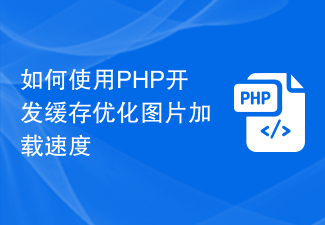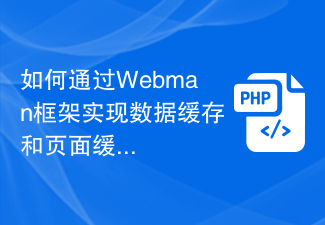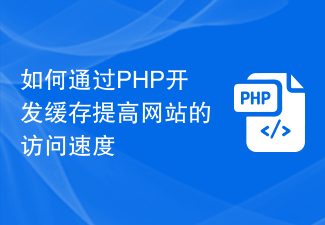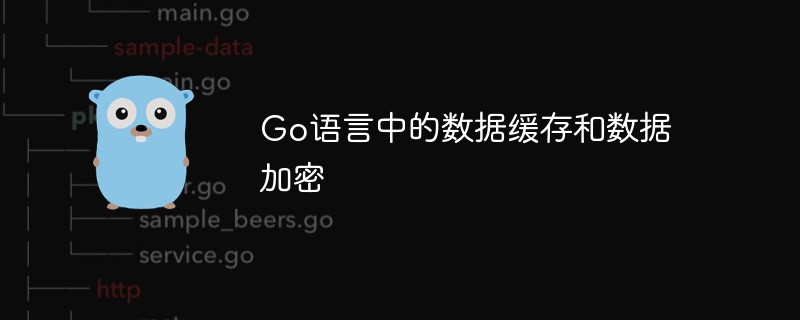
How to implement efficient data caching in PHP projects?
Introduction:
In developing PHP projects, data caching is a very important technology that can significantly improve the performance and response speed of the application. This article will introduce how to implement efficient data caching in PHP projects, including selecting appropriate caching technology, life cycle management of cached data, and usage examples.
1. Choose the appropriate caching technology
- File caching: Use the file system to store cached data. The cached data can be saved on the disk. It is durable and suitable for processing large amounts of data. , but the reading and writing speed is relatively slow.
- Memory cache: Use memory to store cached data. The read and write speed is very fast. It is suitable for processing data with high real-time requirements. However, the data will not be saved persistently and the cache will be lost after the server is restarted.
- Distributed caching: Distribute cached data across multiple servers, using the processing power and memory capacity of multiple servers to improve performance and scalability, but implementation and maintenance are relatively complex.
When choosing caching technology, you need to weigh various factors based on the performance requirements and business scenarios of the project.
2. Life cycle management of cached data
- Cache expiration time: Set the expiration time for cached data. When the data expires, new data will be reloaded and the cache will be updated when accessed again. , which can avoid the problem of outdated cache data.
- Cache invalidation strategy: When the cache data becomes invalid, you can choose to delete, update or reload the invalid cache data from the cache. An appropriate failure strategy needs to be selected based on specific business scenarios.
- Cache cleaning mechanism: As time goes by, cached data may occupy too much memory or disk space, and cached data that has expired or has not been accessed for a long time needs to be cleaned regularly to release resources.
According to different business needs, we can flexibly configure cache life cycle management strategies.
3. Usage Example
Suppose we have an e-commerce website and need to cache product price data to reduce database access and ensure the real-time nature of price data. We can use memory caching to handle this requirement. The following is a simple example:
// 使用Memcache作为缓存技术
$cache = new Memcache;
$cache->connect('localhost', 11211);
// 尝试从缓存中获取商品价格数据
$product_id = 123; // 商品ID
$cache_key = 'product_price_' . $product_id;
$product_price = $cache->get($cache_key);
// 如果缓存中没有找到数据,则从数据库中获取,并存入缓存
if (!$product_price) {
$product_price = getProductPriceFromDatabase($product_id);
$cache->set($cache_key, $product_price, 0, 600); // 设置过期时间为10分钟
}
// 使用商品价格数据进行业务逻辑的处理
processProductPrice($product_price);In the above example, we use Memcache as the caching technology and obtain product price data from the cache through the get() method. If not found, get it from the database and store it in the cache. When storing in the cache, we set the expiration time to 10 minutes, so that even if the price data in the database changes, the real-time nature of the cache can be ensured.
Conclusion:
By choosing appropriate caching technology, good cache data life cycle management and reasonable use of caching mechanisms, we can achieve efficient data caching in PHP projects and improve application performance and response. speed. In specific practice, we can flexibly apply caching technology according to project needs and scenarios, and perform reasonable configuration and tuning to achieve the best caching effect.
The above is the detailed content of How to implement efficient data caching in PHP projects?. For more information, please follow other related articles on the PHP Chinese website!
 PHP中的输出缓存May 23, 2023 pm 08:10 PM
PHP中的输出缓存May 23, 2023 pm 08:10 PMPHP语言中的输出缓存是常用的性能优化手段之一,可以大大提高Web应用的性能。本文将介绍PHP中的输出缓存以及如何使用它来优化Web应用的性能。一、什么是输出缓存在Web应用中,当我们使用PHP输出一段HTML代码时,PHP会将这段代码一行一行地输出到客户端,每输出一行,就会立即发送到客户端。这种方式会造成大量的网络I/O操作,而网络I/O是Web应用性能瓶
 如何使用PHP开发缓存优化图片加载速度Nov 08, 2023 pm 05:58 PM
如何使用PHP开发缓存优化图片加载速度Nov 08, 2023 pm 05:58 PM如何使用PHP开发缓存优化图片加载速度随着互联网的快速发展,网页加载速度成为用户体验的重要因素之一。而图片加载速度是影响网页加载速度的重要因素之一。为了加速图片的加载,我们可以使用PHP开发缓存来优化图片加载速度。本文将介绍如何使用PHP开发缓存来优化图片加载速度,并提供具体的代码示例。一、缓存的原理缓存是一种存储数据的技术,通过将数据临时保存在高速存储器中
 Golang中数据缓存、结果缓存、页面缓存都应当怎样使用?Jun 19, 2023 pm 09:04 PM
Golang中数据缓存、结果缓存、页面缓存都应当怎样使用?Jun 19, 2023 pm 09:04 PMGolang是一门高效、简洁、可靠的编程语言,其在Web应用程序方面的使用越来越广泛。为了优化Web应用程序的性能,开发人员通常需要使用缓存技术来减少资源的访问和提升应用程序的响应速度。在Golang中,数据缓存、结果缓存和页面缓存是常用的缓存技术。在本文中,我们将了解这3个缓存技术的用途和用法。1.数据缓存数据缓存是指将经常访问的数据存储到内存中,以提高
 小程序开发中的PHP数据缓存与缓存策略Jul 05, 2023 pm 02:57 PM
小程序开发中的PHP数据缓存与缓存策略Jul 05, 2023 pm 02:57 PM小程序开发中的PHP数据缓存与缓存策略随着小程序的快速发展,更多的开发者开始关注如何提高小程序的性能和响应速度。其中一个重要的优化手段就是使用数据缓存来减少对数据库和外部接口的频繁访问。而在PHP中,我们可以利用各种缓存策略来实现数据缓存。本文将介绍PHP中的数据缓存原理,并提供几个常见的缓存策略的示例代码。一、数据缓存原理数据缓存是指将数据存放在内存中,以
 UniApp实现数据缓存与持久化存储的最佳方案Jul 05, 2023 pm 08:33 PM
UniApp实现数据缓存与持久化存储的最佳方案Jul 05, 2023 pm 08:33 PMUniApp是一种基于Vue.js的跨平台开发框架,可以将一个项目同时编译成多个平台上可运行的应用程序,如iOS、Android等。在开发移动应用时,数据的缓存和持久化存储是非常重要的方面,本文将介绍UniApp中实现数据缓存与持久化存储的最佳方案,并提供相应的代码示例。一、数据缓存在移动应用开发中,为了提高应用的用户体验,减少网络请求的次数和数据加载的时间
 如何通过Webman框架实现数据缓存和页面缓存?Jul 08, 2023 am 10:58 AM
如何通过Webman框架实现数据缓存和页面缓存?Jul 08, 2023 am 10:58 AM如何通过Webman框架实现数据缓存和页面缓存?Webman是一款基于Python的Web框架,它具有轻量、灵活、易用的特点,并且支持多种插件和扩展。在Web开发中,实现数据缓存和页面缓存是提高网站性能和用户体验的重要手段之一。在本文中,我们将探讨如何通过Webman框架实现数据缓存和页面缓存,并给出相应的代码示例。一、数据缓存数据缓存是将一些频繁访问的数据
 如何通过PHP开发缓存提高网站的访问速度Nov 07, 2023 pm 05:03 PM
如何通过PHP开发缓存提高网站的访问速度Nov 07, 2023 pm 05:03 PM随着互联网的发展,网站的访问速度成为了用户选择一个网站的重要因素之一。对于大型网站,访问量巨大,每个页面请求都可能需要耗费大量的时间和资源。为了解决这个问题,我们可以通过使用缓存技术来大幅提高网站的访问速度。本文将介绍如何通过PHP开发缓存提高网站的访问速度,包含具体代码示例。一、缓存概念及原理缓存是一种将经常使用的数据暂时存储在高速存储器中,以便更快地获取
 Go语言中的数据缓存和数据加密Jun 02, 2023 pm 02:40 PM
Go语言中的数据缓存和数据加密Jun 02, 2023 pm 02:40 PM随着互联网技术的发展,数据的存储和传输变得越来越重要。在这个过程中,数据缓存和数据加密被广泛应用于各种场景中,以保证数据的安全性和高效性。本文将主要介绍Go语言中的数据缓存和数据加密技术。一、数据缓存数据缓存是指将数据存储在缓存中,以便快速访问。常用的缓存系统包括Memcached、Redis等。Go语言提供了多种缓存库,包括go-cache、freecac


Hot AI Tools

Undresser.AI Undress
AI-powered app for creating realistic nude photos

AI Clothes Remover
Online AI tool for removing clothes from photos.

Undress AI Tool
Undress images for free

Clothoff.io
AI clothes remover

AI Hentai Generator
Generate AI Hentai for free.

Hot Article

Hot Tools

MinGW - Minimalist GNU for Windows
This project is in the process of being migrated to osdn.net/projects/mingw, you can continue to follow us there. MinGW: A native Windows port of the GNU Compiler Collection (GCC), freely distributable import libraries and header files for building native Windows applications; includes extensions to the MSVC runtime to support C99 functionality. All MinGW software can run on 64-bit Windows platforms.

mPDF
mPDF is a PHP library that can generate PDF files from UTF-8 encoded HTML. The original author, Ian Back, wrote mPDF to output PDF files "on the fly" from his website and handle different languages. It is slower than original scripts like HTML2FPDF and produces larger files when using Unicode fonts, but supports CSS styles etc. and has a lot of enhancements. Supports almost all languages, including RTL (Arabic and Hebrew) and CJK (Chinese, Japanese and Korean). Supports nested block-level elements (such as P, DIV),

WebStorm Mac version
Useful JavaScript development tools

Atom editor mac version download
The most popular open source editor

ZendStudio 13.5.1 Mac
Powerful PHP integrated development environment






